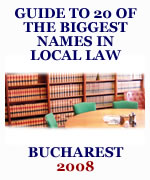Home front
Real estate developments may be booming, but the market in affordable housing has yet to explode, finds Corina Ilie
 |
|
|||||||||||||
Homes for low income citizens and the underprivileged in Romania are available, but the system is suffering from local councils who refuse to build or grant land for affordable housing, particularly in Bucharest.
The Government is now constructing 2,000 social housing units in the country, but this is not a popular move with the capital’s leaders.
“In Bucharest the situation is more complicated,” the Minister of Development, Public Works and Housing, Laszlo Borbely, tells The Diplomat. “Very few sector mayors are willing to cooperate and allocate plots of land for social housing.”
Bucharest Mayor Adriean Videanu has been blatant in his demands to ban social housing in his city, despite the rising costs of rent and sale. While the capital’s growth demands workers across every sector, the City Hall has no programme for promoting affordable housing. Instead it only has plans for people evicted from buildings which are condemned or expropriated.
“I do not want to turn Bucharest into a social city,” Videanu has said. “I want to increase living standards. I will permanently oppose the idea of building social houses in Bucharest.”
Many local authorities are also unwilling to give up land for social housing because the price on the free market they can gain for the plots is higher than the cash available from the Government to exploit the area.
'1') {
require('php/art_auth.inc');
}
?>
Every year Romania’s Government builds homes for around 3,500 under-35s, aiming to help them gain a lift onto the first rung of the property ladder or give the underprivileged a place to live.
Yet the supply of social housing falls short of the EU average. Social renting housing accounts for around 0.8 per cent of Romania’s population, opposed to 8.5 per cent in the Czech Republic, 1.4 per cent in Bulgaria and 1.6 per cent in Hungary. Meanwhile countries such as Finland, Denmark and Sweden ensure that all people who cannot support themselves receive accommodation from the state.
Ownership liberation
In the early 1990s Romanians could buy the Communist-era houses or flats where they lived at a low price. This created a culture of mass ownership - a situation which should have benefited many Romanians, compared to many of their western counterparts who pay mortgages for most of their adult life. Now home ownership in the Romanian population accounts for the largest percentage in the EU, except for Lithuania and Bulgaria, according to the European Social Housing Observatory (CECODHAS).
But Romania’s economic crisis during the 1990s caused a depreciation of the local currency, rising inflation and falling incomes in real terms. This meant many home-owners lacked money to pay for gas, water and electricity, forcing the young to emigrate or leave their accommodation for smaller units, with older people, especially, moving in with their children or friends.
Another problem in the new eastern EU member states is that many Communist living units do not support the demands of a modern European state – including no living rooms or hallways and small kitchens.
In 2001 in Romania an estimate from the UN Economic Commission for Europe predicted that 80 per cent of these units would come to the end of their life in 2021, unless serious maintenance work and repairs were undertaken.
In the last eighteen years few of these flats have been replaced. This has also become harder due to the high costs of land and construction materials.
Meanwhile there is also no accurate up-to-date information on the number of homeless in Romania. French non-governmental organisation Samu Social predicts there are around 5,000 homeless in the capital.
“Most of them do not have any papers,” says Mirela Alexe, general manager of Samu Social in Bucharest. The capital has shelters that can house 330 people in sectors 1, 2 and 3. Meanwhile half of the city, sectors 4, 5 and 6, have no shelters.
Home targets
In Romania, local authorities allocate social houses to married couples under 35, over-18s raised in social care, invalids, pensioners, war widows and war veterans.
These citizens can take out a lease for five years, which can be extended. The rent does not exceed ten per cent of the net family income. Each City Hall pays the rental difference. Local authorities manage the funds from the state and supervise construction.
Last year the Ministry of Development, Public Works and Housing wanted to start a construction programme of sheltered accommodation for people who were evicted from their houses.
But Borbely says that the programme was “a fiasco”.
Romanian City Halls were not interested, he adds. They did not allocate land for construction. Nevertheless this month the Ministry will deliver two blocks of flats with 128 apartments for people whose accommodation were under threat of collapse if an earthquake hits Bucharest again.
“These are not apartments with a low level of comfort,” says the Minister. “We are trying to build civilised dwellings and we have not sacrificed comfort to have lower construction costs.”
The Ministry built the block on Piata Natiunile Unite with the understanding that Bucharest City Hall would pay for the 36 million Euro investment. As we went to press, the capital’s senior authority had not paid up. A spokesperson was unavailable for comment.
The Ministry is launching a pilot housing programme for the Roma community. Borbely believes that these people need a “different type” of housing.
“Roma families need dwellings with gardens, where they can meet and feel as if they were part of the same community,” he says. “They are very connected to one another and we should respect their need to be together.”
But this will be a controversial move, as accusations of segregation based on race may arise. “I wonder if by social housing he means ghettos,” argues Ciprian Necula, programme coordinator for national minorities and Roma specialist.
Previous precedents do not bode well. In the town of Roman, Neamt county, a local authority scheme saw public housing force 2,000 members of the Roma community out of town and into a ghetto two kilometres from the city. The shanty huts had no running water, gas or electricity.
Middle move
Next month the Government will finalise changes in the housing law which should widen the bracket beyond lower income families to have access to social housing.
“Local city councils decide to allocate these dwellings only to people with the lowest incomes in Romania and this is not exactly fair,” argues Borbely. “There are other people who earn more money, but who still can’t afford to pay a regular rent and should also have access to such houses.”
In Poland and Slovenia those with low and middle income are eligible for state-funded social housing.
Young target
Romania also has a state-sponsored programme for young people who cannot afford to pay rent. But this has run into controversy as county councils which allocate housing units do not always undertake their activity fairly.
In 1999 the Government created the National Agency for Social Housing (ANL), now part of the Ministry of Development, Public Works and Housing.
“This is a social programme, but the target is different to those of social housing,” says Gheorghe Popescu, president of ANL. “The most eligible people are employees under 35 with university education, married, with children who do not own a house.”
The law has changed in 2007 and now tenants can buy these apartments after a history of five years’ residence.
This programme was initiated to try and stop the massive emigration of the young educated, who moved abroad because they could not afford to rent or buy apartments. “There are a lot of university graduates who cannot find work in their home cities,” says Popescu. “Instead of moving to other cities because of the lack of housing, they chose to emigrate, earn some money abroad and then come back and buy a house or never come back.”
ANL will build over 20,000 apartments through this programme in all the counties of Romania. Brancusi apartment complex, on Strada Valea Oltului, west Bucharest, is the biggest neighbourhood, with 1,679 apartments.
In 2000 the Ministry initiated through ANL the first mortgage programme in the country, allowing young families to buy apartments and houses at lower prices. In Bucharest ANL is building such a neighbourhood, Henri Coanda, with 49 apartments distributed in nine blocks, near the Baneasa Airport ‘Aurel Vlaicu’.
But ANL has been open to corruption. Individual City Halls have the right to allocate apartments and do not always grant the units to those who fulfil the criteria. Although they target a certain category, apartments built by ANL can be allocated, illegally, to employees of City Halls.
“I was allowed to choose my own apartment in the block built by ANL in Targoviste,” says an employee of the local City Hall, speaking on condition on anonymity. “Even if I was not married, did not have children and was not under 35. It is one of the biggest studio apartments in the block.”
By allowing sitting tenants to buy their property, this raises further fears that the Government has allowed a system of state-sponsored home-building for local council employees, their political party members, family and friends.
The apartments built by ANL are sold, regardless of the area where they are built, at 650 Euro per sqm. People can buy studio flats starting from 30,000 Euro per unit and 110 sqm apartments with prices ranging between 80,000 and 90,000 Euro.
This is a great deal compared to the soaring Romanian property prices today.
City Hall: property speculator
Although Bucharest Mayor Adriean Videanu does not want to build houses for the underprivileged, the capital’s City Hall bought 324 apartments for social housing on the free market, with prices ranging between 110,000 and 140,000 Euro for two-room apartments. As a comparison, this is over 50 per cent the price young people pay for ANL apartments.
City Hall bought around 50 apartments from Irish company Gigant Construct, the developer of flats on Strada Gura Siriului, at a price of 1,000 Euro per sqm. The two and three-room apartments include double-glazed windows and balconies of six sqm.
But this is unlikely to be the first of many similar deals.
“We are not interested in public-private partnerships with the authorities for the construction of social housing, because they do not take [payments] seriously,” says Corneliu Serban, general manager of Gigant. “We received our money for the apartments in Gura Siriului only after a very long time.”
Later on, Bucharest City Hall changed these 50 apartments’ status from ‘social’ housing to ‘emergency’ or ‘necessity’ housing. The new beneficiaries of these flats will be the expropriated owners of properties in the Historic Centre and tenants living in blocks which could collapse in the next earthquake.
Historic eviction
Bucharest’s Historic Centre is undergoing a massive redevelopment programme in an attempt to attract pedestrian visitors to the heart of the city, but many residents living there ‘illegally’ face being kicked out of their accommodation.
Many of these live without water or electricity in a prime real estate. Some have occupied the houses since the 1970s.
According to local authorities there are 10,000 people who live in the area of 50 hectares between the southern branch of Calea Mosilor and Calea Victoriei, around the street of Lipscani. The authorities state 5,000 of these are squatters.
Now the streets and the utilities are undergoing redevelopment. Spanish firm Sedesa has started to pave the streets and bring in large numbers of streetlights. The next stage is to refurbish the buildings. When the houses begin to be revamped, these ‘squatters’ will witness eviction. This was supposed to happen during the summer of 2005 at the instigation of Sector 3. But the completion of this process has witnessed delays of almost three years.
Local business resident, Teodor Frolu, vice-president of the Association of Investors in the Historic Center (AICI), believes that the number of these people is not as high as 5,000. He also says the authorities will face no problems trying to provide these people with social housing. This depends, of course, on whether Bucharest allows any social housing in the city.
“There are only a few hundred people,” he argues. “They illegally became owners of one room in a house and now have to negotiate with the real owners, many of whom had their property restituted, having lost their buildings during the Communist era.”
The completion of the infrastructure work on the Historic Centre is due to finish in the next year, while the entire rehabilitation process should take between four and eight years.
There are around 520 buildings in the Historic Centre. From this figure, 290 are listed as of special architectural interest, some of which date back to the 18th century.

















